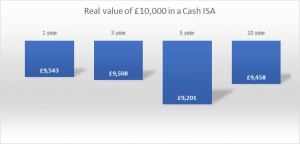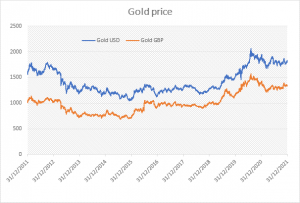Interestingly using the opposite approach to bargain hunters, performance chasers fared considerably better. These investors put money into the best performing sector of the last 12 months, this year that was the Tech and Telecoms sector, which has gone from strength to strength, returning 17.7% in 2021. This strategy has also hit the top half of the performance league over ten years, though this is a period which has been characterised by deeply entrenched investment trends, and a long bull market. Conventional wisdom suggests that when the market winds change direction, performance chasers could find themselves in more challenging territory.
Cash savers have fared worst over the last ten years, posting a meagre 14.2% return, and though base rate has now ticked back up slightly, inflation will more than offset any tiny gains cash savers can expect. Remarkably though, huge sums of money continue to flow into cash, something which even the FCA is now explicitly seeking to address as part of its three-year strategy. The FCA estimates that 8.6 million UK consumers are holding more than £10,000 of assets in cash which could instead be invested. The long-term numbers from our Investor Strategy League show precisely why that might be a good idea, particularly when you consider the effects of inflation, which are shown in the chart below.

Other safe haven assets also find themselves at the bottom of the league table over the last year, and even the last decade. Bond buyers had a challenging 2021, seeing a 5.4% fall in the value of their investment, as improved economic conditions, inflation and the expectation of interest rate rises prompted a reappraisal of the sanctuary provided by gilts. Despite extremely positive conditions for the gilt market over the last ten years, bond buying still only ranks 24th out of 27 investment strategies in the last decade. That’s because in a low interest rate, high liquidity environment, risk assets have done even better. Gilt yields are still extremely low, currently 1.2% on the 10 year bond, which means there could be more pain to come if interest rates normalise.
Gold bugs also had a poor 2021, registering a 3.3% fall in the value of their holdings. With the latest reading showing CPI running at over 5%, that pours cold water on the idea that gold is a good inflation hedge, at least in the short term. Over the last decade, gold has failed to deliver too, returning just 28% for investors, and ranking second bottom in our league table. It should be noted that the beginning of our ten-year comparison period coincided with a bull run in gold, which saw its value peak at over $1,800 an ounce at the back end of 2011. The yellow metal now trades again at around $1,800 an ounce, but British gold bugs have also enjoyed a boost from sterling weakness. Despite gold now trading at roughly the same level as in 2011, it hasn’t been a smooth journey – the gold price fell back to under $1,100 an ounce in the intervening period, and its blushes have really only been saved by the pandemic revitalising demand.

Like Bitcoin, gold is a speculative asset because returns rely on investors being able to offload their holding onto someone else who will buy it at a higher price. You might say that any asset is only worth what the market is willing to pay for it, but stocks and bonds produce cashflows, which provide a basis for valuation, and set a lower limit for prices. Gold has no such safety net, which explains why it exhibits such high levels of volatility, despite being perceived as a safe haven. Gold faces a number of challenges in 2022, in particular the prospects for higher interest rates, which make cash, and bonds, more attractive relative to the precious metal. It’s also possible that Bitcoin may start to take some flows away from gold if it starts to become established in the investment industry as an alternative asset, though the gold market’s much longer history, investment infrastructure, and regulatory rubber stamp stand it in good stead on that front. Gold can perform a role in a portfolio as an asset which behaves a bit differently from the rest, but it shouldn’t make up more than 5 to 10% for most retail investors.
The UK residential property market had a bumper year over the last year, with the latest reading from the ONS showing 10.2% annual price growth. We have assumed a 5% rental yield on top, after costs and void periods, but not taxes, giving property tycoons a 15.2% return over the last year. That makes 2021 the best year for residential property investment in the last decade, though in such a risk on year, a very healthy return was outshone by many other investment strategies. The same holds true over ten years, where a 120.7% total property return is in the bottom half of the performance table.









![[UNS] tax](https://ifamagazine.com/wp-content/uploads/wordpress-popular-posts/788955-featured-300x200.webp)
![[uns] house of commons, parliament](https://ifamagazine.com/wp-content/uploads/wordpress-popular-posts/788873-featured-300x200.webp)




